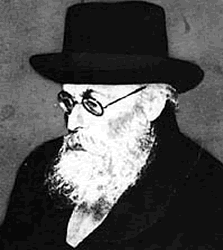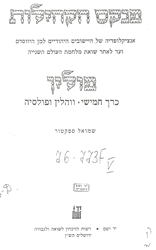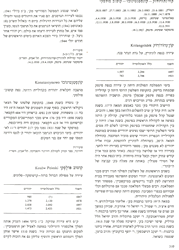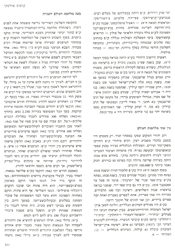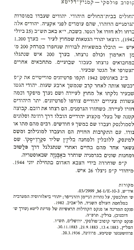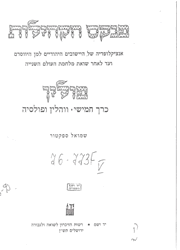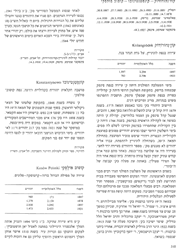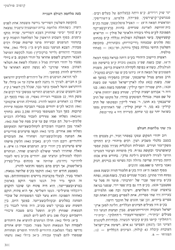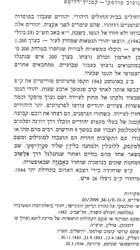I am writing here because my roots lie in Kossow. My mother was born there,
to Zundel Asher Rawicz and his wife Malka Weinstock. Zundel Asher's mother was
Gute Malkeh Karelitz (a relative of the Chazon Ish). Sadly, both Zundel Asher
and Malka died when my mother was 5 years old, she first of cholera, and he
the next year of pneumonia (likely related to the influenza of 1918.) The 6
children moved to Brisk (Brest-Litovsk) to live with the mother's parents. So
I know little of the Rawicz family and of Kossow.
Please include me in any emails for descendents of Kossow. And if anyone has
any information about the people I mention, I would appreciate your sending it
to me. Thanks, and I look forward to checking this website.
Sincerely, Monica
In the Ellis Island site you find;
First Name: Zundel
Last Name: Rawicz
Ethnicity: Russian, Hebrew
Last Place of Residence: Kossowa
Date of Arrival: Nov 07, 1906
Age at Arrival: 40y Gender: M Marital Status: S
Ship of Travel: Kowno
Port of Departure: Liban
Manifest Line Number:
0026
going with family of;
Dereczinsky, Zawel M 36y M Russian, Hebrew Kossowa
0021. Dereczinsky, Chache F 38y M Russian, Hebrew Kossowa
0022. Dereczinsky, Todre M 10y S Russian, Hebrew Kossowa
0023. Dereczinsky, Schlema M 2y S Russian, Hebrew Kossowa
0024. Dereczinsky, Jenta F 11y S Russian, Hebrew Kossowa
0025. Dereczinsky, Sora F 7y S Russian, Hebrew Kossowa
to their brother in law and his cousin; A. Korelitz 91 River street, Hoverhill, Mass.
last name- first- place of origin- year- age
Rawicz, Zundel Kossowa 1906 40
Rawicz, Keile Kassowo1897 19
30 Rawitz, Beile Kosewe, Russia 1912 11
31 Rawitz, Berel Kosewe, Russia 1912 6
32 Rawitz, Elke Kosewe, Russia 1912 9
33 Rawitz, Freide Kosewe, Russia 1912 35
34 Rawitz, Matche Kosewe, Russia 1912 10
Rawicz, Manuse Ruzana 1902 21
Avrohom Yeshaya Karelitz (popularly known by the name of his magnum opus Chazon Ish),was born in Kosavo in 1878.
Karelitz received his education from his father who was head of the local Beth din.He moved to Vilna in about 1920, and became close to Rabbi Chaim Ozer Grodzinski, consulting with him in all religious and communal matters. Encouraged by Grodzinski and with Rabbi Abraham Isaac Kook's help, the Chazon Ish settled in the Palestine in 1933. His house in Bnei Brak became the address for thousands who sought his guidance. Karelitz manifested unusual talent and diligence from an early age. He devoted his life to the study of the Torah and Talmud, although also learning such sciences as astronomy, anatomy, mathematics, and botany, since he felt that knowledge of these subjects was necessary for a full understanding of various aspects of Jewish law and practice. After his marriage, he continued to lead an extremely modest life, his wife providing for their needs while he spent day and night in deep Talmudic study. He did not have any children. The reputation of the Chazon Ish for saintliness and knowledge was widespread and people from all walks of life would frequent his home, for scholarly discussions or to seek advice on religious, business, or personal problems, or simply to receive his blessing
Holding no official position, the Chazon Ish nevertheless became a recognized worldwide authority on all matters relating to Jewish law and life. He was not appointed as communal leader, yet he exerted an enormous influence on the life and institutions of religious Jewry, especially in Israel. He did not publish many responsa, but became a supreme authority on halakha.
He had an immense influence on Haredi Judaism in Israel, whose formative period coincided with his leadership.
David Ben-Gurion, the prime minister of Israel, visited him once to discuss political-religious issues. The Chazon Ish argued that the secular community's needs should defer to those of the religious community. He used the Talmudic discussion (Sanhedrin 32b) of two camels which meet on a narrow mountain pass as a metaphor. A camel without goods was expected to defer to a camel laden with goods; similarly, the Chazon Ish expected secular society to defer to religious society, which bore the "goods" of tradition. [1]
(To this Ben-Gurion responded that the "secular" camel was not in fact "without goods", since secular Zionism had led to the establishment of a state and the physical protection of Israelis. The Chazon Ish replied that this was unimportant, when combined with widespread rejection of Jewish tradition. The story is often misquoted to be about two wagons not two camels; however, the Talmud mentions camels, and witnesses at the meeting have said that the Chazon Ish quoted the Talmud correctly.)
In 1911 he published his first work on Orach Chayim and other parts of the Shulchan Aruch in Vilna, anonymously under the title Chazon Ish, meaning "Vision of Man", the name by which he became almost exclusively known.
Although essentially an academic scholar, he applied himself to practical problems, devoting much effort to the strengthening of religious life and institutions. His rulings on the use of the milking machine on Shabbat and on cultivation by hydroponics during the sabbatical year are two illustrations of his practical approach. A model of modesty and kindness, the Chazon Ish wrote over 40 books in clear Hebrew, in polished and precise style, which are models of lucidity and brilliance.
In contrast to other great Achronim such as R' Chaim Soloveitchik, the Chazon Ish is known for avoiding formulaic or methodical analysis of Talmudic passages, instead preferring a more varied and intuitive approach similar to that of the Rishonim.
The true legacy of the Chazon Ish is the promotion of clarity in Talmud study, devotion in the worship of God, and loving-kindness in human interactions.
A powerfully moving portrait of Chazon Ish by his onetime disciple, the Yiddish poet and novelist Chaim Grade, is to be found in Grade's epic novel "Tsemakh Atlas: Di Yeshive" (New York & Los Angeles: Yiddish Natzyonaln Arbeiter Farband, 1967-1968); translated in English as "The Yeshiva" [Curt Leviant, tr.] (Indianapolis: Bobbs-Merrill, 1976-1977). Chazon Ish appears there as "Rav Yeshayahu Kossover."
Retrieved from "http://en.wikipedia.org/wiki/Avrohom_Yeshaya_Karelitz"
Avrohom Yeshaya Karelitz (better known as his magnum opus, Chazon Ish) was Born in Kosavo in 1878. Karelitz received his education from his father who was head of the local Beth din.
He moved to Vilna in about 1920, and became close to Rabbi Chaim Ozer Grodzinski, consulting with him in all religious and communal matters. Encouraged by Grodzinski and with Rabbi Abraham Isaac Kook's help, the Chazon Ish settled in Palestine in 1933. His house in Bnei Brak became the address for thousands who sought his guidance.
Karelitz manifested unusual talent and diligence from an early age. He devoted his life to the study of the Torah and Talmud, although also learning such sciences as astronomy, anatomy, mathematics, and botany, since he felt that knowledge of these subjects was necessary for a full understanding of various aspects of Jewish law and practice. After his marriage, he continued to lead an extremely modest life, his wife providing for their needs while he spent day and night in deep Talmudic study. He did not have any children.
The reputation of the Chazon Ish for saintliness and knowledge was widespread and people from all walks of life would frequent his home, for scholarly discussions or to seek advice on religious, business, or personal problems, or simply to receive his blessing
Holding no official position, the Chazon Ish nevertheless became a recognized worldwide authority on all matters relating to Jewish law and life. He was not appointed as communal leader, yet he exerted an enormous influence on the life and institutions of religious Jewry, especially in Israel. He did not publish many responsa, but became a supreme authority on halakha.
He had an immense influence on Haredi Judaism in Israel, whose formative period coincided with his leadership.
David Ben-Gurion, the prime minister of Israel, visited him once to discuss political-religious issues. The Chazon Ish argued that the secular community's needs should defer to those of the religious community. He used the Talmudic discussion (Sanhedrin 32b) of two camels which meet on a narrow mountain pass as a metaphor. A camel without goods was expected to defer to a camel laden with goods; similarly, the Chazon Ish expected secular society to defer to religious society, which bore the "goods" of tradition. [1]
(To this Ben-Gurion responded that the "secular" camel was not in fact "without goods", since secular Zionism had led to the establishment of a state and the physical protection of Israelis. The Chazon Ish replied that this was unimportant, when combined with widespread rejection of Jewish tradition. The story is often misquoted to be about two wagons not two camels; however, the Talmud mentions camels, and witnesses at the meeting have said that the Chazon Ish quoted the Talmud correctly.)
In 1911 he published his first work on Orach Chayim and other parts of the Shulchan Aruch in Vilna, anonymously under the title Chazon Ish, meaning "Vision of Man", the name by which he became almost exclusively known.
Although essentially an academic scholar, he applied himself to practical problems, devoting much effort to the strengthening of religious life and institutions. His rulings on the use of the milking machine on Shabbat and on cultivation by hydroponics during the sabbatical year are two illustrations of his practical approach. A model of modesty and kindness, the Chazon Ish wrote over 40 books in clear Hebrew, in polished and precise style, which are models of lucidity and brilliance.
In contrast to other great Achronim such as R' Chaim Soloveitchik, the Chazon Ish is known for avoiding formulaic or methodical analysis of Talmudic passages, instead preferring a more varied and intuitive approach similar to that of the Rishonim.
The true legacy of the Chazon Ish is the promotion of clarity in Talmud study, devotion in the worship of God, and loving-kindness in human interactions.
A powerfully moving portrait of Chazon Ish by his onetime disciple, the Yiddish poet and novelist Chaim Grade, is to be found in Grade's epic novel "Tsemakh Atlas: Di Yeshive" (New York & Los Angeles: Yiddish Natzyonaln Arbeiter Farband, 1967-1968); translated in English as "The Yeshiva" [Curt Leviant, tr.] (Indianapolis: Bobbs-Merrill, 1976-1977). Chazon Ish appears there as "Rav Yeshayahu Kossover."
Retrieved from "http://en.wikipedia.org/wiki/Avrohom_Yeshaya_Karelitz"
at
19:24:16
My mother's family was from Kossov, and my grandparents belonged to
the Kossover Society in New York.. I have been told that Kossov is in
Austria,
Poland and Russia, at various times. I had maternal DNA analysis done
last
year, and the DNA report stated that I was predominantly ashkanazi
Polish and
Russian. Does anyone have any further information regarding Kossov,
and/or the
Kossover Society? My grandmother passed away in 1964, and my
grandfather died
in the flu epidemic of 1919, so there's no one to ask any longer. My
mom
passed away 7 years ago and was not particularly interested in her
ancestry.
My grandmother was Pauline Drucker Buchner and my grandfather was Max
Buchner,
and settled in the Bronx around 1910. Thanks for listening...
Not just becasue I am a tay-sachs carrier, a trait from pale families that intermarry, but I think my Kosovsky family had alot of cousin intermarriages back and forth no matter what towns the cousins lived in--many persons I contact seem to have a Goldman/ Kosovsky /Chemerinsky connection
growing up in chicago, my mom, born in 1906, thought her surname of Kosovsky [our grandfather changed it to Kosovske, his brother spelled it Kosovski] to be an odd name, but I have found out that in Europe it was as common as "Johnson" and can be spelled over 30 phonetic ways--
actually a New York researcher named Bob Kosovsky has about 22 different phonetic spellings on his data base and he has contacted many different Kosovsky families with the varient spellings-- have you ever contacted him?
....then in addition to translators at entry ports, different countires have diffferent spellings for it--even with ska endings for a girl and sko endings for a boy and j next to a y and i next to a y; I once found a Russian professor whose surname had a kiy ending for the name kossovskiy--
I have a Maysha Itzock and a Moishavella* Kosovsky on my tree as well as a Yomi but I do not think these translate to Teddy--tho Meishavela* might it means Moshe wolf and it has lots of phonetic spellings* these guys are from a group of 4-5 brothers whom I have no information about
i don't have a teddy kosovsky on my tree but i might have such a relative--there are 4-5 branches of kosovsky /kosofsky on my tree that were never completed as rabbi Y.D goldman who was my main source of information for my tree never gave me all the information I needed--there were 4-5 brothers who went to New York in the late 1880's--Teddy could be from one of those 4 families
I think I once saw a Teddy Kosofsky on SSI social security death index
my great great great grandfather was Yeudel Dovid [Yehuda Dovid] Kosovsky was born before 1800 and was a rabbi dayann [jewish judge] in the town of Drochitchen/ Drohiczyn/ Drachichyn/ Drogichin/r Drochichyn--the town was originally called Davechyonovichi or Dovecherovichny until 1655
he had at least 9 kids
my great great grandfather Eliezer Sholo'mo was one of rabbi YD Kosovsky's sons, the other were: the oldest daughter Esther, rabbi Ahron, Yisroel Kosofsky, 2nd born child Matshi Itzock, and the 4-5 brothers for whom I have no tree are: the 8th born child Alec/Elijah, the 6th born child Yomi who took the surname of "Kay" in america, Hirsch Leib Kosofsky, Meisha Velvel kosofsky, I do not know why some were Kosovsky and others Kosofsky, and I don't know if there was a sister Pesil
Eliezer Sholo'mo was the father of rabbi Aaron Kosovsky who was my great grandfather.
Aaron and his son [ my great uncle] Sam, came to America around 1903? tho other records give later date , so Sam would not get drafted into the czar's army--they left my great grandmother Rachel Leah Peshkowsky Kosovsky behind with daughter Pesil- because -they were really on the run from the czar's army
Aaron had other children but Meyer age 17 drowned while swiming in the bug river, and two twin sisters had died in infancy; his other son, my grandfather Yehuda Laeb "Leon" Kosovsky lived in odessa where he worked in a factory as there were no jobs in his town--Leon was named after his mom's dad Yehuda leib Peshkowsky--in 1906, Leon, his mother Racquel Leah, his wife Manya and their baby Sema left Odessa for America--Sema/Simone was my mother, Celia Kosovske Biblin
my great grandfather Aaron/Ahron Kosovsky had an uncle also named Aaron/Ahron Kosovsky [they were both rabbis] he was one of the nine mentioned above
the great great uncle Aaron Kosovsky and his wife Kayle/Kalith had a daughter named Chaia or Chavay who was born on the Zasihnov estate in Bereyu which is in Osha a town outside of Minsk and Pinsk
Chavay Kosovsky married rabbi MeishaVella/Mosche Zev/Morris Wolf Shkolnik,1860-1941 [son of rabbi Chaim (yeshiva?) shkolnik from the town of Slonim/ Kossova
after Chavay died in 1931, this rabbi Shkolnik remarried and his 2nd wife was named Dora
one of chavay's sons was Sam Shkolnik [1909-1996] he and his wife Muirel 'Bess' [Goldstein] were the parents of 2 children--one of these children was Selwyn/Sel
and on eilat's website [her e-mail address is listed in the address posting of this e-mail] Chavay's decendant's posted pictures and information about their tree--this genealogy was done mostly by Dee/Delores who is still alive and is the wife of the late dentist dr Selwyn/Sel shkolnik--bob kosovsky might have an e-mail for Dee as she contacted him concerning his kosovsky research
esther kosovsky married rabbi Yossel/Yosef goldman [son of rabbi tzmach and his wife nisha chana from the town of khomsk/chomsk--but they also lived in brest] one of their sons Mushe Zev is Steve's great great grandfather who lived in New York, another son was rabbi Elijah/Eliyahu who married Chia Lipshif [from Brisk] and one of their sons was rabbi Yeduel Dovid Goldman who married [his own 1st cousin] Sarah Esther daughter of rabbi Mordechi Zindel/Zundel Rubenstein from the town of Molodechno near Vilna --the Goldman tree is confusing because they have alot of cousin intermarriages
apparently Sarah Esther's mother was a Goldman and her father a Rubenstein--her mom must have been a sister to rabbi Tzmach Goldman or a sister to his wife Nisha Chana
I was told that my great great grandfather Eliezer Sholomo's wife Razael was also from the Goldman family and that her mom Chi Cyril may have been a Goldman as well
plus i know nothing about the wife and mother of rabbi YD Kosovsky--perhaps they were Goldmans too
rabbi Y.D. Goldman had 3 sons, and 1 daughter named Eileen
Eileen is the mother of Kinereth,Donnie, Miriam, and Naomi
I think we may be
related. My family, (descendants of Lazar Perskie and Mindel Dithy Perskie),
are originally from Volozhin and came to the US in the mid-19th century. Check
my genealogical Website for more information. Also, please email me your email
address. THanks. Jana Perskie
From: Marion Werle <werle@>
Date: Fri, May 20, 2011 at 7:58 PM
Subject: RE: Kossovo
To: Eilat Gordin Levitan <eilat.gordinlevitan@gmail.com>
Here are the pages from Pinkas Ha-Kehilot Polin......
I found the photos I was referring to and will scan them. Nadav had sent me some copies of others, and I’ll have to find where I filed them – they were color copies from originals......
I look forward to your translation. I have translations of some of the other shtetlach I’ve been researching (from other volumes – I actually own the volume on Latvia). I have been writing up some of my research, which is why I’m reviewing a lot of my old files. I think this will be a good thing for your website. ....
Hi
I read the interesting site about kosow poleski and i would like to
ask about 2 things that are relating also to my family from kosow.
First, my family from that town was called the Berman family, which
had flour station. I would appriciate any information you have about
these family. I'm looking also for information about my grandfather's
brother, Chaim berman ,that survived the holocaust and was never seen
again.
Second, I am looking for
Peter Lewis ,
pictures about his family, named Iliwitski. This family was in
marriage connection with my family, the Bunewicki family.
I would like to share my information with him.
I also came back 2 months ago from a roots journey in kosow and i will
be glad to share pictures .
Thank you
Meirav
Israel
My father, Abraham Shapiro (b1898) emigrated to America from Kosovo in
1910 with his mother Pesha Shapiro nee Valonsky and sister. There
were preceded by my grandfather Samuel Shapiro, a shoemaker, who fled
conscription during the Russian-Japanese war in 1905. Many of my
grandmother's family emigrated to Palestine at the end of the 19th
century with the name changed to Mahler. This is about all I know of
my Kosovo ancestor, I wonder if there is anyone who might read this
that might have more information: my wife and I are contemplating a
trip to Europe in the Fall and hope to include a visit to Kosovo, if
that is possible.
Perry Shapir
jpshap@gmail.com
It might be another Kosovo which is also now in Poland.
Yad Vashem report by Tzipora Mahler of Israel:
Adela Freidman was born in Kozova, Poland in 1895 to Simkha and
Rakhel. She was a housewife. Prior to WWII she lived in Kozova,
Poland. During the war she was in Kozova, Poland. Adela was
murdered/perished in 1941 in Belzec, Poland at the age of 66. This
information is based on a Page of Testimony (displayed on left)
submitted by her daughter.
From: Ruthy <rutiperco@yahoo.com.ar>
Hi!
Somehow I found your very interesting website but couldn´t find anything related to my father´s family, supposedly from Kosuv Poleski: here are some name maybe they ring a bell to anyone, or please let me know if I can look for information elsewhere. Thank you
Perec Percowicz
Menachem Mendel Percowicz
Noah Percowicz
Leja Josielowska
No dates of arrival to Buenos Aires Argentina. No certain birthdate (circa 1910?)
Ruth Percowicz
Buenos Aires
From: Ruthy <rutiperco@yahoo.com.ar>
Hi!
Somehow I found your very interesting website but couldn´t find anything related to my father´s family, supposedly from Kosuv Poleski: here are some name maybe they ring a bell to anyone, or please let me know if I can look for information elsewhere. Thank you
Perec Percowicz
Menachem Mendel Percowicz
Noah Percowicz
Leja Josielowska
No dates of arrival to Buenos Aires Argentina. No certain birthdate (circa 1910?)
Ruth Percowicz
Buenos Aires
From: Bob Fitterman <bobf@jhu.
Hi. I just learned about your web site last week: it's incredible! I have been looking for photos of Kosow Poleski and you had just what I'd hoped for on http://eilatgordinlevitan.com/kossovo/kossovo.html. I even discovered that one of the photos I have was taken in the same spot as #6.
I am piecing together a bit of my family history. I want to make a short video: it isn't for commercial distribution, just for family and friends. I'd like to include photos #13 and #11 in my work, but I want permission to do so. Also, I'm hoping to get higher resolution scans. Is that possible to do? Who owns the original photos?
Thanks.
Bob Fitterman
New York, NY
From: Marion Werle
Here are the pages from Pinkas Ha-Kehilot Polin. The section on the last page is close to the margin, but nothing got cut off. The yizkor book is pretty big to scan (although it is pretty small as far as yizkor books go) – it is also very poorly organized – no real index, although one of my projects was going to be indexing all the names in the book. Lots of photos as well – probably some of the same ones as on your website. Where in LA do you live? I am in the north SF Valley. Maybe I could lend you the copy. My cousin Miriam Aaron (also a Molchadsky when she lived in Israel, although they came to NY after WWII) was the one who copied it for me, and she had planned to translate it when she retired, but she has kept very busy doing other things.
I found the photos I was referring to and will scan them. Nadav had sent me some copies of others, and I’ll have to find where I filed them – they were color copies from originals.
I look forward to your translation. I have translations of some of the other shtetlach I’ve been researching (from other volumes – I actually own the volume on Latvia). I have been writing up some of my research, which is why I’m reviewing a lot of my old files. I think this will be a good thing for your website.
I need to get in touch with Nadav as well – it is probably getting close to the end of the quarter and I think he is also a TA, but I’ll try to contact him soon.
Marion
I stumbled across your web page for Kossovo, which is my maternal gm’s shtetl. For reasons that I can’t fathom, Kossovo is included as part of the Ruzhany Shtetlinks page, and my second cousin Nadav Molchadsky (who has also sent you some photos) has contributed to the Ruzhany page as well. His grandfather (a much younger brother of my gm) was born in Ruzhany, and apparently the family variously lived in Kossovo, nearby Alba (Halveh), and Ruzhany over the years. Nadav is my second cousin, although he is the same age as my younger son.
I have been reviewing some of my research and came across a copy of the entry for Kossovo in Pinkas Ha-Kehilot Polin (I guess since it was part of Poland between WWI and II). I never got around to getting it translated (my college-level Hebrew is very rusty), and was wondering if you would be able to use it for your webpage if I scan it for you? It isn’t that long (about a page and a half), and I’m sure it would be easy for you to translate. I copied it at YIVO during one of the NY genealogy conferences in the late 1990’s and then stuck it away in a folder that I just discovered. I also have some photos that I can probably send you as well. My surnames are MOLCHADSKY and RATNER, although I know very little about the Ratner relatives. My ggf, Yosef Molchadsky married my gm’s mother, Shendel Ratner, who died after having 4 children, and he remarried her sister Golda and had a bunch of other children, one of whom was Nadav’s gf. I have done extensive research into the other three branches of my family, but haven’t done as much on this branch. Ironically, when I started, we knew more about this branch than all the others, although most of it is from family stories and photos, rather than archival evidence. Half of my gm’s family settled in Canada (my gm lived in NY for a few years before joining her brothers in Canada) and adopted the surname Aaron. Nadav’s and my ggf was the rabbi/shochet/mohel for the Lipton, Saskatchewan farm community from 1909 until he made aliyah in 1922. His family got stuck in Europe during WWI and after the war, a number of his children made aliyah. The two daughters that stayed in Europe died in the Shoah with their families. Nadav and I have different information regarding the daughters’ married names, and we still need to sort out the information (since those are the photos I have).
Please let me know if you’d like me to send you a copy of the Kossovo article. I haven’t asked Nadav if he wants a copy or wants to translate it – he’s a PhD student at UCLA and is pretty busy, although I do owe him a call. I also have a photocopy of the Kossovo y.b., which a cousin of mine copied for me a long time ago at YIVO. I notice that the YB site on JewishGen has translated the names at the end of the book, but I’ve done a lot of lookups for various people over the years. Robert Kraft actually sent me a bound copy at one point (he had made it and was going to donate it to a library, but I forget what happened) as thanks for doing some lookups for him some time ago.
Anyway, this turned out to be a lot longer than I had intended. Hope to hear back from you.
Marion Werle
From: LEO B. <leonardob@fibertel.com.ar>
Date: Wed, May 25, 2016 at 4:11 PM
Subject: contact
To: egl.comments@gmail.com
Hello,
My name is Leonardo Bornsztein (Leizer Borstein), my father was Abraham Borstein, who was born in Kosov Poleski in 1930.
He was supposed to be the only survivor of his family. In 1939 his family was killed and he was the only survivor at the age of 9. He spent the war with the partisans.
After the war, he was rescued by the Red Cross and came to live to Argentina at the age of 18, after living two years in the kibutzim in Rome, Italy.
He died in 1986.
The information about him I found in the Museum of Holocaust in Washington DC.
I know his parent´s names were Leizer Borstein and Guitel Natalia Novakworska (sounds like this).
I would like to know there is any information about any relative in your records.
Best regards,
Leonardo Bornsztein
Argentina
IMost likely the family perished in 1942 not 1939. The eastern and northern area of (then) Poland was under Soviet control from 1939 until June of 1941. In Yad Vashem I found; Bobe Winnik nee Bornshtein was born in Kosow Poleski, Poland in 1905. She was a housewife and married to Bentzion. Prior to WWII she lived in Bereza Kartuska, Poland. During the war she was in Bereza Kartuska, Poland.
Bobe was murdered in the Shoah in 1942.
This information is based on a Page of Testimony (displayed here) submitted by her relative.
David Vinik
